I recently spent a sleep-deprived night at the “Graybar Hotel” – the nickname for the Island’s only jailhouse. The handsome nineteenth-century white clapboard building at 149 Main Street looks like many others in Edgartown. Only you won’t find it in a Martha’s Vineyard guidebook, and you wouldn’t want to stay there unless you had to. That’s because it houses some thirty prison inmates, who are more apt to appreciate its euphemistic nickname than you might be. More formally, it’s called the Dukes County Jail and House of Correction.
The police car carrying me arrived at the back of the jail around 9:30 p.m. on a Friday night – close to prime time for arrests. The outside gate slid open, and we moved into a vehicle trap enclosed with high barbed-wire-topped fencing. Nobody gets in or out by accident. Sitting in the back of the cruiser, hands cuffed behind me, I realized I was riding in a cage on wheels. There were no handles on the doors nor window cranks; a grill separated me from the officer driving. In such circumstances, I realized, freedom is a privilege never to be taken for granted.
I was marched up a few steps inside to the booking area and asked to face the wall. After removing my handcuffs, the officer on duty, Deputy Erika Weron, patted me down and told me to remove my belt, shoes, and all items from my pockets and purse.
The counter that separates arrestees from the jail staff rises to chest height, in case by some lunacy an arrestee might be tempted to leap over it and attack the officers on duty. Next I was grilled for vital statistics like height, weight, age, next of kin, and other information, including previous arrests. Imagine having to dredge up youthful misdemeanors like shoplifting, graffiti, or political demonstrating. Not a pleasant process.
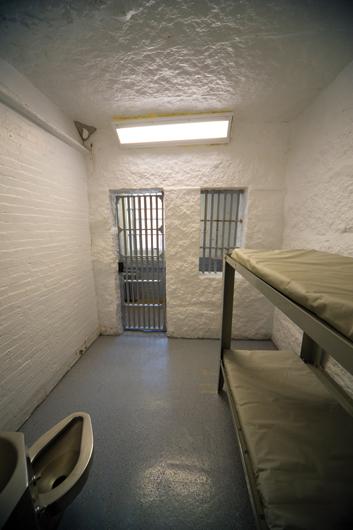
Facing front, then in profile, I posed for my jailhouse photos. Next came a computerized fingerprinting machine, where the officer entered my prints, which are set up to go directly to the state police and FBI. The days of rolling fingertips on messy ink pads are long gone.
Then I was ushered into the women’s holding cell. I knew I had an eye-opening, exhausting night ahead. The windowless room, about eight by twelve feet, contains bunk beds spartanly outfitted with vinyl-covered mattresses as comfortable as gym mats, and a combination toilet-sink, screened from the door by a waist-high wall. Not the kind of privacy most of us are used to. I received one blanket, no pillow. When the heavy holding-cell door swung shut, I was left to my own claustrophobic devices. One person arrested five years ago hanged himself from a sheet tied to an exposed pipe in the men’s holding cell. It was not too difficult to understand that kind of despair.
There was plenty of time to think about past indiscretions. I remembered how as a teenager I went swimming with friends in a private reservoir, and the police came but luckily didn’t arrest us. Another time I rolled my car coming home from what was then the Hot Tin Roof nightclub, and I wouldn’t have liked to take a Breathalyzer test. Who among us can claim to be 100 percent free of arrestable offenses?
But I was not detained for a specific crime, and the jail staff knew I was a journalist researching a story. What took me to the Graybar was an interest in seeing firsthand the cloistered world of the incarcerated and getting an understanding of what it feels like to spend time behind bars.
During my time overnight at the jail, I was allowed out of my holding cell to watch the intake process with genuine arrestees. Sometime before midnight, two men who had been taken into custody outside an Oak Bluffs bar arrived at the jail for processing. The charges were disorderly conduct and assault. Before the first one was brought in, the arresting officer came around behind the intake counter, removed his pistol, and secured it in a gun locker. This protocol protects officers and jail staff from arrestees grabbing a police officer’s gun in an attempt to escape.
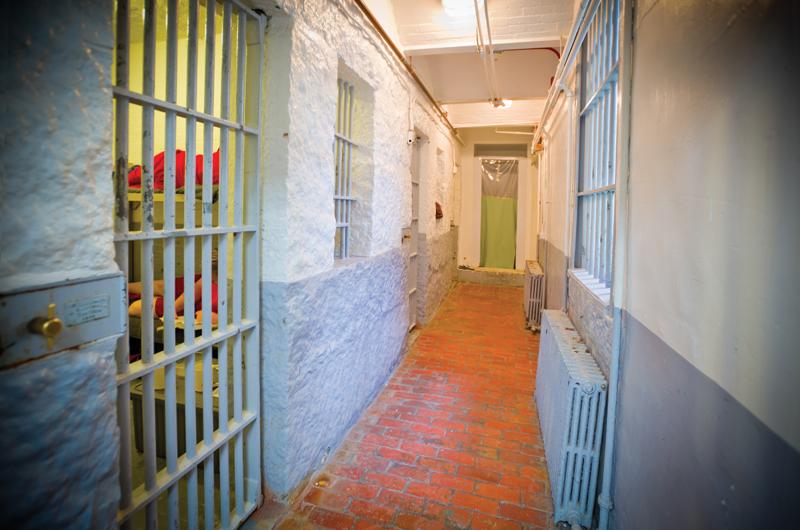
Officer Nathan Vieira, who was on duty that night, read the first man his rights, informed him of the charges, and outlined the bail process. A bail commissioner’s job includes coming to the jail any time of day or night to set bail; detainees usually don’t wait more than three or four hours before bail is set.
Asked how much he’d had to drink, this arrestee answered, “A couple of beers.”
“They all say that,” Officer Vieira told me.
The second man had to wait outside in the cruiser, since arrestees are processed one at a time. After his booking, he was taken in his socks to join his friend in the four-bed holding cell for men.
A little later came a man in protective custody. This procedure is used when police decide someone needs to be confined for his own safety. Among other functions, it’s a discretionary way to handle drunken and disorderly conduct. This person was put through the arrest protocol and confined in a separate holding cell, known informally as the Drunk Tank. Brought out periodically until he could pass a Breathalyzer test and be sent on his way, he kept up a high-decibel rant all night.
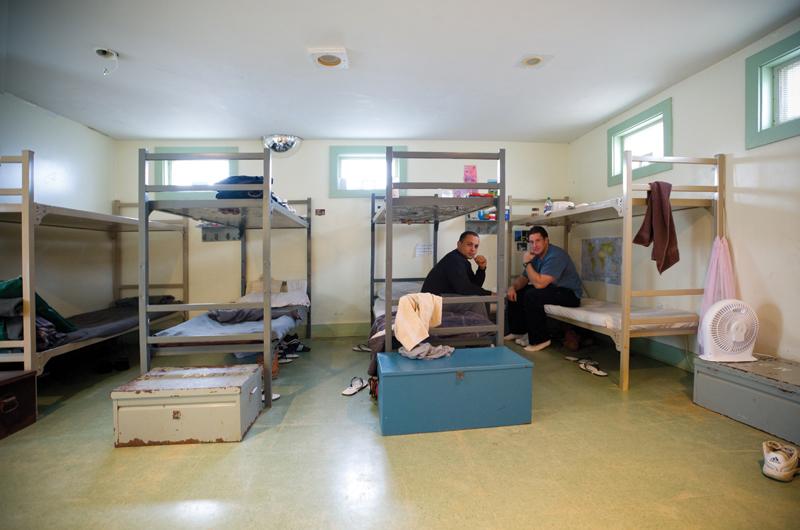
Although the booking room and holding cells are part of a self-contained unit in the jail, this man’s caterwauling could be heard by all the inmates in the brick annex that comprises the confinement section of the jail. Certainly his running commentary kept me awake most of the night.
Had he been arrested on an OUI (operating under the influence) charge, staff would have requested that he step up to the Breathalyzer machine. If he refused to take the breath test (which is connected to the Motor Vehicle Department) or failed it, he’d get an automatic six-month suspension of his driver’s license.
“In this computerized age, the world has shrunk,” Sheriff Michael McCormack says. Your arrest record follows you wherever you go.
Not many women have the opportunity to spend the night in jail here, since the Vineyard’s full-time jail population is exclusively male. It does not have space to accommodate women other than for temporary stays, before transfer to off-Island facilities. Sheriff McCormack and the Dukes County Jail Task Force hope to change that inequity through the construction of a new jail with housing for women.
The Graybar confines the one percent of the population who, as Sheriff McCormack explains it, “can’t behave themselves.” On the day I visited, thirty-seven inmates were in residence (the average fluctuates between twenty-five and thirty-five). Thirteen dressed in red jump suits were confined under maximum security or pre-sentencing; ten at medium (in yellow); fourteen at minimum (in blue, or green for prerelease). Inmates start in a holding cell, then land in the ten-bed dormitory to see if they can get along with others in the jail population.
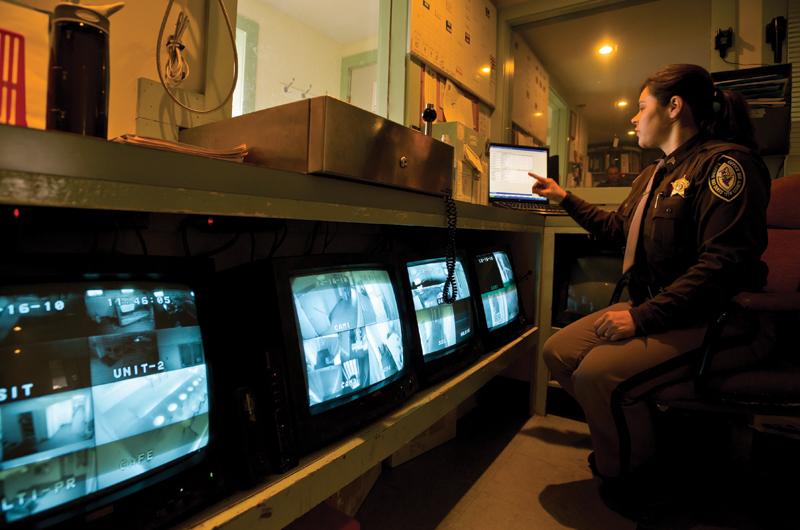
“We actually use housing as a reward,” the sheriff explains. The next step is a two-person cell, followed by singles for prerelease inmates whose sentences are almost up and whose designation allows them to do community service.
For the Record
My jail experience taught me a lot. For starters, jail prisoners make up a bona fide part of the Island community, and most of them look forward to rejoining the rest of us when their terms are up. “It’s the courts that punish people; our job is to rehabilitate them back into the community,” says Sheriff McCormack, who was reelected last year for his third term and has run the jail since his election in 1998.
The current Dukes County Jail building was built in 1873, but records housed at the Martha’s Vineyard Museum date the first county jail back to 1789. Arthur Railton’s research, published in The Dukes County Intelligencer in 1997 and 1998, has uncovered colorful stories of how the Island’s prisoners, usually confined as debtors, escaped on a regular basis. In one of the more outlandish incidents, a former town clerk enlisted two of his sons to help him demolish the then-wooden “gaol,” as the jail was then called. His goal was to free a third son – a former constable and tax collector and himself a debtor – who had already sawed his way out once several days earlier.
Landscaped with mature lindens, maples, and a rare American elm, the front of the Graybar contains offices and meeting rooms where the daily business of running a jail takes place. Sheriff McCormack and his wife, Mary Lee, lived there for eleven years while he served as deputy superintendent and she as director of human services, before they moved in 1984 to West Tisbury, where they live now.
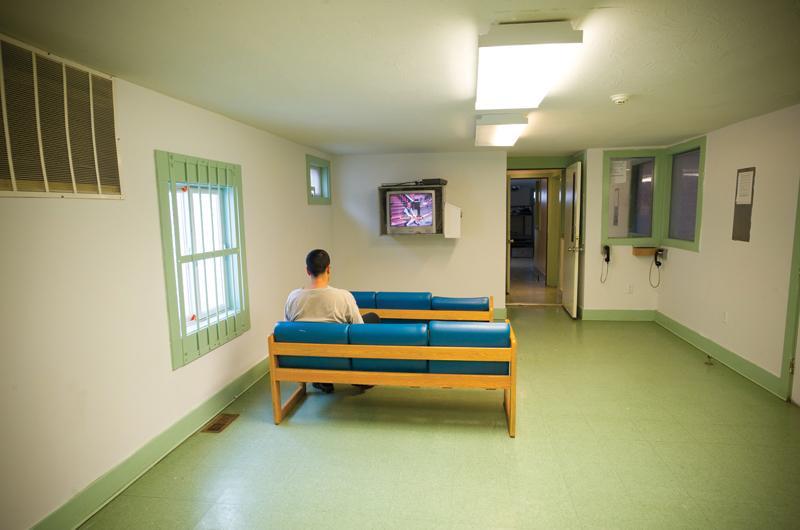
Once the site of a whale-oil processing plant, the lot extends beyond the deceptive-looking front of the jail to a brick annex attached in back, which reveals a more jail-like appearance. It houses twelve one- or two-person cells, stacked back to back, and enclosed with heavy steel bars and eighteen-inch-thick granite walls. As the sheriff observes, this section looks as if it came right out of the Wild West, built at a time when prison philosophy favored more punitive methods. As late as the early 1980s, cells had buckets instead of toilets.
“Now contact is important,” the sheriff says. Cell doors stay mostly unlocked from 6 a.m. to 11 p.m. to allow prisoners to socialize in the day room, stocked with books, a television, computers, and games. Six more cells were added in the eighties, along with a dormitory addition for another ten inmates in 2005. Once you turn onto Pine Street and see the chain-link fencing around the jail’s holding and exercise areas, this section looks like the real thing.
Annually, the jail handles approximately one thousand admissions – eighty a month on average – with the highest number of inmates arriving in summer through alcohol- or drug-related arrests; Vineyard crime happens most often from 10 p.m. to 2 a.m. on weekends. The average length of stay is eight months for sentenced inmates, followed in some cases by probation or parole (finishing your sentence out of jail). Admissions also come from cases adjudicated at the courthouse farther down Main Street. According to the sheriff, a high percentage of arrests consists of nonresidents who have come to the Island to party or vacation and find themselves involved in a range of offenses involving alcohol, drugs, disorderly conduct, assault and battery, and property crimes.
Not that more serious crimes don’t happen on the Vineyard. An assault that happened this past June in Vineyard Haven led to the victim’s death. In 2007, a body was found in Edgartown harbor, and the prime suspect was never found. In 1998, two killings occurred five weeks apart, followed by an attempted murder. Perpetrators of more serious crimes end up in state or federal prisons off-Island.
If the Vineyard does not quite qualify as the den of inequity described in popular Vineyard-based mystery series by Cynthia Riggs or the late Philip Craig, it does have its share of felonies. Even the most law-abiding citizens can have lethal auto accidents, arguments that lead to violence, and incidents of domestic abuse. Burglaries and even armed robberies occur, along with sexual assault, blackmail, drug deals. But for the most part, the Island is the peaceful spot we would like to think it is.
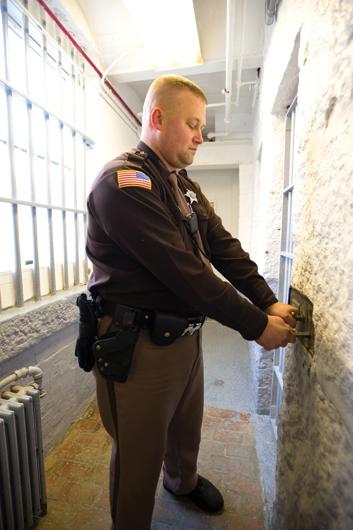
“This is a small community,” the sheriff observes. “It takes care of its own. The community is somewhat insulated, because the boats stop running at night.”
All Kinds of Rehab
Special Sheriff David O’Sullivan serves as deputy superintendent of the jail, and a team of specialists works under him with inmates to facilitate the rehabilitation process. Registered nurse Juleann VanBelle addresses the health problems of inmates, including AIDS, HIV, and hepatitis C. Understandably, anxiety is common among prisoners, and when necessary she dispenses sleep medication or tranquilizers and sets up talk therapy.
“We work closely with Island Counseling [Center at Martha’s Vineyard Community Services] and do clinically based therapy for substance abuse,” she explains. The majority of inmates are diagnosed with substance abuse and some with mental health issues as well. “Because of our small size, we’re able to treat the individual rather than the symptoms,” she explains.
The jail’s rehabilitation program offers a range of vocational classes, from small-engine repair and carpentry to farming and business workshops. Inmates can also take classes in life skills, such as the fathers’ group, which includes a program for videotaping inmates reading stories to their sons and daughters; anger management; and a poetry group, a workshop encouraging self-expression through writing. In the area of health and nutrition, Chris Hargy, the jail’s Johnson & Wales–trained chef who produces a hundred meals a day, has run a culinary arts program in conjunction with the FARM Institute. Inmates can also learn CPR, first aid, and recreational boxing. In addition, there’s a ten-hour construction certification program from the Occupational Safety and Health Administration (OSHA), as well as ServSafe, a food-handling-safety certification program. These programs increase inmates’ skills for future employment and encourage their reintegration into the community.
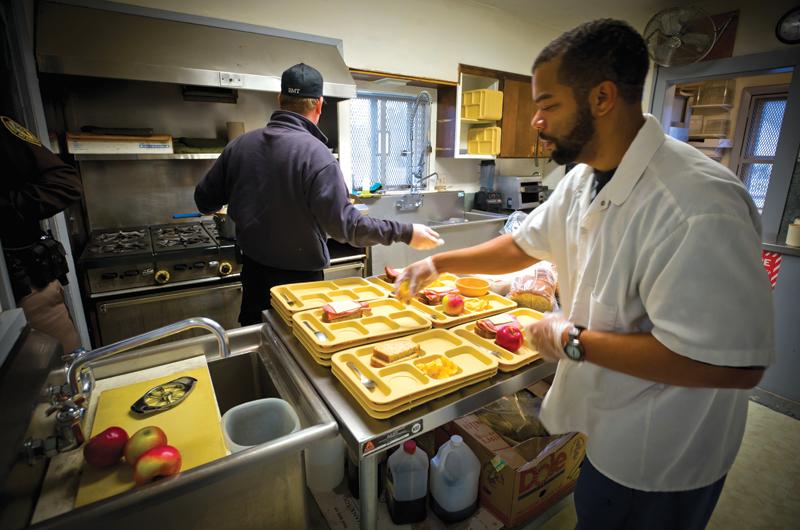
“Education is one of those key components necessary for succeeding on the outside,” says Katy Upson. She serves as the jail’s education facilitator, doing testing, running the GED (high school equivalency) program, and overseeing use of the jail’s two computers with Internet access (computers in the common room have no Internet access) for online college courses. “A big part of the jail’s job is educating the community to see what it is that we do here,” she explains, “because [the inmates are] coming back to the community. They need your help: rooms, jobs, mentorship. We’re looking for that involvement.”
Major Rosemary Mok, the assistant superintendent for the Department of Human Services (who recently transferred to another facility in western Massachusetts), says, “We want to offer opportunities.” She and Juleann VanBelle collaborated on a grant proposal to develop community initiatives at Martha’s Vineyard Hospital for former prisoners. “Not everyone takes part in them,” Major Mok adds. Unemployment and lack of financial resources, however, are the biggest causes of rearrest, along with substance abuse. “Every incarceration has a stigma,” Major Mok observes, “and the smaller the community, the more known the individual is.” An inmate, for instance, may have grown up with or gone to school with a member of the jail staff.
Despite these attempts to equip prisoners for returning to the Island community as contributing citizens, there are always people who can’t live within society’s rules. And there are prisoners who escape. “Look at our security,” says Sheriff McCormack, referring to the white picket fence in front and the chain-link fence in back. “They have twenty-four hours a day to figure how to get out.” He recounts the story of one prisoner who paid a passerby on the street $20 to bring him a hacksaw blade, then sawed his way out. Another left the low-security prerelease area and ran off to see his girlfriend. Yet another missed the bus to his work-release job and instead took another to visit his family.
“They get to know every officer’s footstep,” says Deputy Weron. “You have to learn to deal with it.”
“The people who we keep here have made bad decisions,” says the sheriff. “The bad people go to state prison.” The maximum length of jail time on the Island is two and a half years, compared to five, ten, fifteen, and twenty years or life in state or federal prison. The worst scenario is when someone returns whom the staff thought was going to make it. “That’s the saddest part, when you walk by and see someone back inside,” adds Katy Upson. “We really get to know the inmates. The relationships are different, but when people return, it just emphasizes the community has failed. This is a community service.”
Inmates Speak
Nobody knows the jail experience better than the inmates themselves. As Major Mok says, “I understand institutional life from the point of view of someone who gets to go home at the end of the day.”
I interviewed a handful of inmates ranging in age from nineteen to thirty-six for a sense of what life is like on the inside. Their commentary follows, edited for continuity and to protect the inmates’ privacy.
“Jail ain’t no fun for nobody. I just stay to myself. I don’t really fit in,” says one inmate. His jail day begins at 5 or 5:30 a.m., when he gets himself up, then joins the other inmates for breakfast at 6:30. Until yard time at 10 a.m., he usually reads – recently The Da Vinci Code or the Bible. Outdoors he lifts weights and does cardio work like jogging, jumping rope, and basketball. Lockdown for inmate counts comes at 11:45 a.m. before lunch. Afternoon for him means killing time with books, card games and cribbage, watching TV, or working on the computer. It’s also a time for counseling and workshops such as anger management and Bible study. He studied for his GED, and he calls the fathers’ group “awesome.” Another lockdown starts at 4 p.m. “to get ready for chow.” The food, he says, is “delicious – lasagna, fried chicken, shepherd’s pie, fried eggs, pancakes, sausage. I gained fifty pounds.”
This prisoner also described the contrast between incarceration on the mainland and on-Island. “It’s nothing like here. The holding tanks are so much smaller. They strip-search you there. It’s a lot more stressful. There’s a lot more lockdowns, and it’s a lot more secure. You can’t even finish a meal if you’re at the end of the chow line. Here you have more freedom. They help you.”
When a new prisoner arrives, everybody introduces themselves. “We try to help each other,” he says. But, he adds, it can get rowdy, with bickering and fights. “If you put your hands on someone, it leads to an ‘inside charge’” (disciplinary action dealt with in-house; outside charges involve the courts). If a major infraction of rules occurs, like tobacco brought in from the outside (the facility is nonsmoking), inmates trading meds or holding pills (instead of swallowing them), a lockdown may follow. The authorities even bring in dogs periodically to search cells for drugs.
“Hopefully you learn,” this inmate says. He praises the jail staff, adding, “I’ve never been anywhere where people are so pleasant. The charges I had – that’s not me anymore.” He looks forward to becoming a positive role model for his children.
Another inmate describes his first three nights in jail: “You spend seventy-two hours in a holding cell. It was hard to sleep, so I read myself to sleep. You’re in a place you don’t want to be. Music has kept me together.” He also joined the writing workshop run for inmates by West Tisbury poet laureate Fan Ogilvie.
“I have a lot of support. I had a lot of time to really think,” he says. “It’s not really that bad. There’s good food. I keep with certain people I can really trust. Others, they are two-faced. It’s like a kiddie camp, but you’re doing time. Your time is being wasted – it kills me. It really hurts that you’re still not with the people you want to be with.
“I go outside, work out, listen to music, go to book club, to boxing, small building, engineering. I don’t like violence, but boxing is a way to let out a lot of stress, a lot of anger.”
A third inmate came to the Island with a bunch of friends, got into a scuffle on the beach, and found himself doing time. He calls the Graybar “great, because it’s small and the food is good. There’s no structure though – other jails have more structure – and nothing’s by the book. It’s chaotic. You can behave and be the best, but the people who get what they want complain. They ask for the single cell.
“This isn’t a jail where people get into fights. There’s no real criminals. If you do get into a fight, you get outside charges,” he says, then mentions a medical procedure he wasn’t able to get, saying, “It’s so small, they don’t want to pay for anything.” This prisoner has worked on the jail road crew that picks up trash. “It’s boring,” he says. “It’s embarrassing having a van following. But I don’t care.”
He was looking forward to qualifying for a single cell, but when he was living in the dorm, he accidentally broke a friend’s arm wrestling. “They were about to give me outside charges, but he [the friend] wrote the sheriff.” The inmate still spent a week in isolation and was reduced to code yellow. “I had almost made green,” he says. “I just recently got blue. There’s reds too. We’re mixed. It’s weird.” (The jail has a waiver allowing it to mix high-risk inmates with others.) “I like to work out. Now that I am blue, I can go outside without the c.o. [correctional officer]. I think mostly about my girlfriend.
“That’s the only thing that gets me – the boredom. For probation you have to find a job. It’s unreal for me. I don’t know anybody on the Island. I’m never coming back.”
Another inmate came to the Graybar from a Boston-area facility. He says, “I got sent here because I was told that by coming to this institution I could probably work on the outside.” Though he says it turned out not to be true for him because of mandatory sentencing rules, the sheriff suggests that might not have actually been the case.
“I see the captain and major every day. They stop by the unit two or three times a day. You can pull them aside and say, ‘I’m not getting along with my celly.’ For me the dormitory was weird. From where I had just come from, it was four-man cells. I’d forgotten how small this jail is.
“I did the fathers’ group twice. Never had it elsewhere. I do miss my children. I don’t get visits. Near a holiday, we make cards. The oldest one died in a stabbing. That took a very bad toll on me. The sheriff was very supportive. He let me go to the funeral.
“I read a lot. I did before. Reading soothes my mind. I try to feed my mind. I play cards, spades, cribbage, chess, watch TV. I played basketball every day until I injured my back. There are not many things to do around here. You have kids who are young, so you sit around and talk, mix with the fellows. I wouldn’t say they’re friends. I call them standbys. Everybody lives their life different. You have to be careful. Here is like a foster home – everybody’s waiting to find a home.
“When I wake up it’s, ‘Oh, I’m still in jail.’ I do a lot of meditating. I do it at nighttime after lockdown. Me losing my kids when I got here was hard. Life is short. That it’s on an island with access on a boat means you got to pay to get here. Not everybody has the financial resources. I separated while incarcerated. I asked my wife, ‘Where did I go wrong?’ ‘You’re locked up,’ she said. ‘I can’t have that in my life.’ I thought we had too many years together to give up.
“I’ll get through it. You have your ups and downs with the officers. This place doesn’t rub me the wrong way. No big jail was meant for an island like this. The food is very different than most jails. Some guys think this is what it’s always like. But you’re not eating processed food; you get real milk. Nobody goes to bed starving.
“At many institutions, friends and family mail things to you, put it in your canteen account. Here you have access to the canteen days and canteen time at 9 p.m. At midnight, four a.m., they’ll bring you something.
“I said no to drugs. The temptation is not a problem. I know to kick it in the butt. The mental pain is the worst. Some kids, they think this is jail time. They don’t know how good they have it.”





